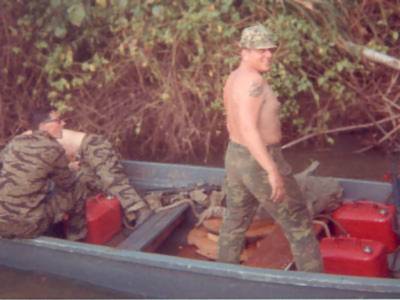| |
|
|
|
Robert Leroy Worthington
Chief Petty Officer
UDT-13, TF 116, USNAVFORV United States Navy Redondo Beach, California May 20, 1933 to April 12, 1969 ROBERT L WORTHINGTON is on the Wall at Panel W27, Line 69 See the full profile or name rubbing for Robert Worthington |
  |
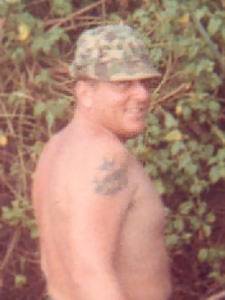
|
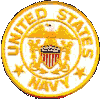
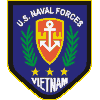
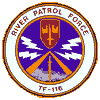
| |
|
Doc Worthington was a diving supervisor on the USS Permit (a nuclear submarine). He came on board the Permit around 1963. Doc had operated with the Marines on some occasions before his tour on the Permit. When I was growing up, I used to go into the arcade occasionally. There was a shooting game in there, with a bear and targets on both sides and the stomach of the bear. I got to be pretty good at making that bear dance for me whenever I would shoot it, as it would turn the opposite direction every time I shot one of those targets. Little did I know how prophetic that game would become later in my life, when I was doing river operations on Patrol Craft Fast (PCF) or swift boats in Vietnam. On April 12, 1969 I was involved in a well-planned and perfectly executed Viet Cong heavy weapons ambush inflicting damage to every swift boat on the operation. It also accounted for three Americans killed and thirty-nine wounded, with Vietnamese Marine casualties of equal severity during one of the most horrific river boat battles during the war. I graduated from Basic Underwater Demolition Seal (BUD'S) class 46 in 1968 and spent the rest of the year doing additional training before I left for Vietnam in February of 1969. I accomplished things such as Airborne School, SEAL Indoctrination, Closed and Semi-closed circuit diving. Because I was one of the people that had completed SEAL training, I was assigned to go down to the southern area of Vietnam in the Rung Sat Zone 172 miles south of Saigon to blow up bunkers and attack villages while running the rivers, doing whatever needed to be done. I worked with a number of different units, like Special Forces in Hai Tien laying mines and booby traps, Mike Force out of IV Corps clearing villages as well as running the rivers with the Brown Water Navy checking sampans and pulling fish stakes which tangled up the screws of our boats. During this entire time, I was assigned to was Underwater Demolition Team 13, Golf Platoon. We worked off of the USS Westchester County (LST-1167). This was a World War II tank landing ship running out of An Thoi, which is the southern-most tip of Vietnam. We stayed on board the ship along with the Seawolf helicopter crews. The river boats were parked alongside and we would climb cargo nets stretched along the port side of the ship to get on and off the boats with our gear. All of the demolition and ammunition was stowed in the hold of the LST, where the tanks went during amphibious landings in WW II. We would then travel into Viet Cong territory on a regular basis from our shipboard base. Later that year, the entire operation was moved to a bunch of barges tied up together in the middle of one of those rivers. That base was named Seafloat (it was renamed Seaflop by disgruntled sailors under their breath) and was manned by SEAL's, UDT, EOD, Junk Force, Seabees and the Brown Water Navy. But that's another story. I had been on station for about two months when a Coast Guard cutter pulled in and anchored close to where our LST was supporting the operations. The cutter's big cheese were aboard to observe and get combat action ribbons as applicable. Little did they know, but the area of operations they had entered was going to soon create problems for everyone there. Oh well, regrets don't last long in war. Unfortunately, neither do memories. A joint US/Vietnamese operation named Silver Mace II was scheduled to head out at 1630 hours. It was scheduled to be three days long and we were going to take Vietnamese Marines up the narrow Rach Duong Keo Canal and work the area. Our detachment was also slotted to blow a number of bunkers along the way, so we took along 800 pounds worth of explosives. There were 17 people on board the number 43 PCF (Patrol Craft Fast) boat, six PCF crew, ten UDT men and one Sealords Staff Officer along with the explosives and the normal compliment of guns and ammo. The swift boat officer, LTJG Donald Glenn Droz, pulled into the river in eighth position, last in the line of 50 foot aluminum PCF boats. Our boat was unwieldy and slow due to excess weight. As we left the mouth of the river, deep in the Mekong Delta, all of us were in full combat gear, including flack jackets and steel helmets. This was in 90 degree weather and 95% humidity, with the sun beating down on us. However, our adrenaline was running high, because this was a very hostile area. I was on the rear deck port side when I heard people shooting automatic weapons up river. A claymore mine had been triggered on the lead boat. Then a murderous fusillade of rocket, recoilless rifle, machine gun, and small arms fire ensued. Every boat was being fired upon, as we were traveling upriver through the kill zone of an ambush set up by a company of about 75 to 100 Viet Cong. Because there were eight boats traveling up river the VC had plenty of time to sight in on the slow boat that was last in line. Her position as last in the file, aggravated by her heavy load, combined to seal her doom. As the lead boats were exiting the kill zone and scrambling to safety upstream, the 43 was just arriving. All the other boats put the pedal to the metal, while the 43 succumbed to her bulk, falling farther behind until she was relatively alone, the only thing for the VC to aim at, in the center of the kill zone. A B-40 rocket crashed into the helm and killed LT Droz, while another rocket came toward the stern and went under the flak jacket of our Corpsman, Chief Hospital Corpman Bob Worthington, instantly killing him and wounding Gunners Mate Guns3 Rickey Hinson and me, Seaman Randy Piper, in the process. When the boat's Officer in Charge died, his body fell onto the wheel while the boat was traveling at full speed, so it careened into the bank right at the kill zone. The lucky thing was that when the boat hit the bank, the angle was such that the hull was at a 45 degree angle leaning away from the ambush. The unlucky thing was a bunker not 20 feet from the bow of the boat and there were two VC in it. The enemy did not organize immediately and that left us time to place ourselves throughout the boat. Well, we were a little too busy to take stock of the situation. We were all firing our weapons on full automatic. Things get a little dicey when you're being fired at from right in front of you and both sides, while the only egress you have is the river behind you. Anyway, Signalman 3rd John Lowry and Signalman 3rd Art Ruiz got off the boat, then moved around it below the bow for coverage, and to keep us from being overrun. Seaman Mike Sandlin, who had been shot by an AK-47, was carried up there after he had a morphine shot for the hole in his left thigh. LTJG Peter Upton moved up to the bow of the boat and LT Chris Lomas went inside the pilot house to lend his hand in first aid for the Boat Captain, which turned out in vain. While Signalman 1st John Campbell, Seaman Pat Broderick, Rickey Hinson and myself were firing from the stern, the guys on the bow were trying to communicate our position, but the radio on board was destroyed. Then Lomas used the PRC 25 radio we had brought along, but there was so much traffic on the line that no one was able to get through. This was because every boat had casualties and no one knew we were stuck on the bank. Our radio was also cutting in and out, since it had been shot up. We were putting out covering fire on the stern with M-16's and M-79's. The angle on the 50 cal's was too high to allow the crew of the boat - Boatswain's Mate 2nd Wayne Langhofer, Engineman 2nd Ed Jones, Radarman 3rd Mike Modansky, and Gunners Mate Guns 2nd Bob Horburger - to use them effectively. Broderick, who was next to me at the time, thought my ear was shot off. My steel pot had been shot off and either a bullet or shrapnel parted my hair. The bottom line is that the blood and sweat had mixed together and was dripping off my ear. As I mentioned, some of the guys got off the boat and headed toward the bow. John Lowry started forward with his M-60 machine gun and Artie Ruiz was right behind him. One of the VC's popped up out of that bunker and threw a Chinese grenade at John. John got so flustered he dropped the machine gun and ran for the water. In doing so, he bowled into Ruiz and they both fell into the river. When the grenade went off, Lowry picked himself up and started throwing grenades into that bunker, as did the guys on the bow of the boat. Ruiz, however, was put out of action. Shrapnel from the grenade had lacerated his throat and he was in trouble. When the action started, the Seawolves [UH-1 helicopters from HA(L)-3] off the LST were scrambled and were en route within minutes. PCF 38, seventh boat in the file, was just heading out of 43's sight when she realized her trailing sister was missing. She tried to return and rescue the crew at the ambush site. She got a rocket in the pilot house for her troubles, severely wounding her OIC and rendering the steering useless. The coxswain's skillful manipulation of the twin screw throttles enabled the boat to limp out of the kill zone without suffering further damage. The problem was the lack of coordination and everyone trying to talk on the radio at once. The helo pilot finally yelled for everyone to shut up, so he could find out what was happening on each boat. It was then that the communication on the 43 boat was able to be heard. The 38 boat had also reached the medevac area and passed the word of the dire straits the 43 boat was in. The command boat, PCF 31, and PCF 5 were thereby motivated to come back to assist us. By the time the Seawolves came over our position, we had been involved in a firefight for 20 minutes in the worst place a person can be, the middle of the ambush. While we were dropping M-79 rounds on the VC, the helos were shooting rockets at the company of VC that were trying to flank our position. The remaining members of our boat crew set up firing positions to provide a 360 degree perimeter. All of us were firing whatever weapons we had available and periodically some of us would feed ammo and explosives throughout the boat. I had to move Doc Worthington's body out of the way to get ammo out of the cabin and feed it to the bow and stern. While I was in the cabin, I happened to glance out the starboard porthole and saw Ruiz lying unconscious in a pool of blood and caked in mud from the mangrove swamp. I thought he was dead and when I came back out I yelled out "Ruiz has had it". By the time PCF 31 and PCF 5 came back to pick us up we had been in that escapade for 45 minutes. Both boats entered the kill zone with guns roaring and arrived intact at the scene of battle. Thirty-one maneuvered into a position adjacent to the wreckage while 5 poured out covering fire. We loaded everyone on board the 31 boat and went on down the river with our guns blazing. Once we reached the other boats, we offloaded our dead and wounded, then put them on medevac choppers to the LST and cutter, thus keeping the Team's legacy intact - bring out all teammates we went on a mission with. I was amazed that Ruiz had survived, when I saw him at my feet at the ambush site, I lifted him up onto the 31 boat. He was given a tracheotomy on the cutter and medevaced to Japan. Wisely, the boats refused to risk a night transit and bivouacked on the bank of the river with security out. That night I learned that the Officer in Charge of Silver Mace II had the call sign of Dipsy Doodle (the handle sure fit). He was a Coast Guard Commander. I never felt he had the training to be where he was, especially since he was in charge, although I have to give him and the boat crew of PCF 31 credit for coming back to pick us up. I didn't know until years later that the Coast Guard was in charge of all the coastal and riverine operations for Sealords. That was definitely the point when I decided I would get out of the Navy after doing my time. I'd had enough of men being in charge who didn't know what they were doing and wouldn't listen to those that did. After we accomplished our mission, we headed back down the river. Now I really felt like the bear in the arcade. When we got to where the remains of the 43 boat was, I was amazed. Ten minutes after we got off the boat, the engines, which were running throughout the firefight, caught on fire and set off the explosives and mortar rounds. Her remains were a terrible reminder of the day before. Towards nightfall the sweeps were halted and the Marines formed protective barriers for the night. The swift boats were released from support duty and headed back to the relative calm of the sea. We had been lucky in a lot of ways and it was a hell of a learning experience. When we got back to the LST and cleaned up, we started searching for any weapons that were missing from the firefight. The M-60 was a priority and it was found in a VC village a few weeks later. We also held memorial services for our dead. Out of the 17 men on the 43 boat, 2 were killed in action and 6 UDT men were wounded in action. Worthington got a Bronze Star posthumously. Ruiz, Campbell and Sandlin also got Bronze Stars for their actions. I don't know what happened regarding the boat crew. The rest of the UDT Detachment got Navy Commendation Medals except for Lowry. Our fearless leaders couldn't figure out how to award him a Silver Star, even though he had earned it in spades. This was all due to the fact that he had not been injured. He was getting ready to take a shower after we got back from the operation, when I saw what looked like a large blackhead on his butt. He was told to go see the ship's corpsman and check it out. Come to find out it was shrapnel from the grenade. So, he got a well-deserved Silver Star after all. This article stands out as a tribute to the raw courage and brute will of those men still living.
|
A Note from The Virtual Wall

The ambush led to three dead and 33 wounded sailors. The other two men who died are remembered on The Virtual Wall:
|
|
Medics on the Wall memorial which honors the Army Medics and Navy Corpsmen who died in Vietnam. |
| Contact Us | © Copyright 1997-2019 www.VirtualWall.org, Ltd ®(TM) | Last update 08/15/2019. |
